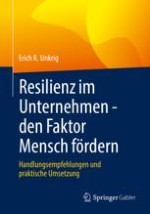2021 | OriginalPaper | Buchkapitel
2. Resilienz – ein kurzer Einblick in Theorie und Praxis
verfasst von : Erich R. Unkrig
Erschienen in: Resilienz im Unternehmen - den Faktor Mensch fördern
Verlag: Springer Fachmedien Wiesbaden
Aktivieren Sie unsere intelligente Suche, um passende Fachinhalte oder Patente zu finden.
Wählen Sie Textabschnitte aus um mit Künstlicher Intelligenz passenden Patente zu finden. powered by
Markieren Sie Textabschnitte, um KI-gestützt weitere passende Inhalte zu finden. powered by
Zusammenfassung
-
welche Beobachtungen und Überlegungen Forscher*innen zu Konzepten der personalen und organisationalen Resilienz inspiriert haben,
-
dass es deutliche Schnittmengen bei den Faktoren gibt, die eine Wirkung auf die Entwicklung von resilienzfördernden Fähigkeiten haben,
-
wie sich grundlegende Resilienzmodelle entwickelt haben,
-
dass es vor allem personale und soziale Faktoren sind, die resilientes Verhalten ermöglichen,
-
warum ausgerechnet die Katastrophen der Raumschiffe Challenger und Columbia zum Nachdenken über zentrale Handlungsfelder der Resilienz anregen.
